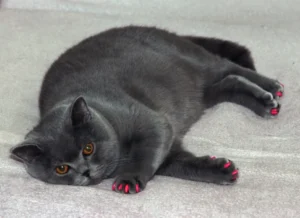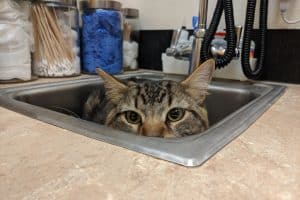Diabetic cats may experience weakness in their back legs, causing concern and worry for their owners. Understanding the reasons behind this issue can help provide the best care for your feline friend. In this blog post, we will explore the potential causes of why your diabetic cat’s back legs may be weak and what steps you can take to address this issue.
What is Diabetes in Cats?
Diabetes in cats is a common metabolic disorder that affects their ability to regulate blood sugar levels. Similar to humans, cats can also develop diabetes when their bodies either don’t produce enough insulin (Type 1 diabetes) or become resistant to insulin (Type 2 diabetes). This results in high blood sugar levels, which can lead to various health complications over time.
One of the lesser-known complications of diabetes in cats is weakness in the back legs. This occurs when the nerves in the cat’s legs become damaged due to uncontrolled diabetes, leading to a loss of muscle mass and strength. As a result, cats may experience difficulty walking or standing, particularly in their hind legs.
Symptoms of Diabetes in Cats
When it comes to identifying diabetes in cats, there are several common signs and symptoms to watch out for. These include increased thirst, frequent urination, weight loss, and changes in appetite. However, it’s essential to note that weakness in the back legs can also be a symptom of diabetes in cats.
If your cat is displaying weakness in their back legs, it’s crucial to have them evaluated by a veterinarian. They can perform blood tests to diagnose diabetes and recommend an appropriate treatment plan to help manage the condition and improve your cat’s quality of life.
Additional Unique Insight: In addition to weakness in the back legs, diabetes in cats can also lead to other neurological symptoms such as impaired coordination and difficulty jumping. This further highlights the importance of early detection and management of diabetes in felines.
Remember, early identification and treatment are key to helping your diabetic cat lead a healthy and active life.
Impact on Mobility
Diabetes in cats can have a significant impact on their mobility, especially when it comes to their back legs. Weakness in the back legs is a common issue for diabetic cats due to nerve damage, known as diabetic neuropathy. This condition affects the nerves controlling the hind limbs, resulting in weakness, wobbliness, and an overall lack of coordination. As a result, your fuzzy feline may struggle to jump, climb, or even walk properly.
Treatment Options
When it comes to helping diabetic cats with weak back legs, there are several treatment options available. First and foremost, it’s crucial to work closely with your veterinarian to establish a comprehensive treatment plan. This may include medications to manage blood sugar levels, such as insulin injections or oral medications. Additionally, diet changes can play a significant role in managing your cat’s diabetes and improving their overall health.
In some cases, physical therapy or exercises tailored to improve strength and coordination in the hind limbs may be recommended. Providing a comfortable environment for your cat, with easy access to food, water, and a litter box, can also help alleviate mobility issues. Regular veterinary check-ups are essential to monitor your cat’s condition and adjust treatment as needed.
Remember, every cat is unique, so what works for one may not work for another. Be patient and persistent in finding the right combination of treatments that work best for your diabetic cat with weak back legs.
Additional Unique Insight:
- Acupuncture: Some pet owners have found that acupuncture can be beneficial in helping to improve nerve function and mobility in diabetic cats. This alternative therapy can be considered in conjunction with traditional treatments for a holistic approach to your cat’s care.
Exercise and Rehabilitation
If you’ve noticed your diabetic cat’s back legs are weak, incorporating regular exercise and rehabilitation can be a game-changer. Just like us humans, cats benefit from movement to strengthen muscles and improve mobility. Consider gentle activities like gentle stretching, controlled walking, and even swimming (if your feline friend enjoys water). These exercises can help build strength in their back legs, making it easier for them to move around comfortably. Remember, always consult with your vet before starting any exercise regimen to ensure it’s safe and beneficial for your furry companion.
Preventing Complications
To prevent complications associated with weak back legs in diabetic cats, it’s crucial to stay proactive and vigilant. Regular veterinary check-ups are key to catching any issues early and addressing them promptly. Additionally, maintaining a stable blood sugar level through proper diet and insulin administration is essential for overall health. Provide a comfortable and safe environment for your cat, ensuring easy access to food, water, and litter boxes. By staying on top of your cat’s care routine and monitoring any changes in their condition, you can help prevent further complications and improve their quality of life.
Additional Tip:
Invest in ramps or steps around your home to help your diabetic cat navigate elevated surfaces more easily. This simple addition can reduce strain on their weak back legs and make everyday movements less challenging for them.
Holistic Approaches
If you’re looking to help improve your diabetic cat’s strength and mobility in their back legs through holistic approaches, consider incorporating acupuncture or hydrotherapy into their treatment plan. Acupuncture can help alleviate pain and inflammation, while hydrotherapy can assist in building muscle strength and improving circulation. Additionally, exploring dietary supplements such as omega-3 fatty acids or glucosamine may also benefit your cat’s joint health and overall well-being. It’s essential to consult with a holistic veterinarian to determine the most suitable holistic approaches for your furry companion.
List of Holistic Approaches:
- Acupuncture: Consider incorporating acupuncture sessions to alleviate pain and inflammation.
- Hydrotherapy: Explore hydrotherapy treatments to help improve muscle strength and circulation.
- Dietary Supplements: Look into incorporating omega-3 fatty acids or glucosamine supplements to support joint health.
Interesting Facts
Did you know that diabetic cats are more prone to developing neuropathy, a condition that can cause weakness in their hind legs? This neurological disorder can lead to impaired coordination and muscle weakness, impacting your cat’s ability to move around comfortably. It’s crucial to monitor your diabetic cat’s condition closely and consult with your veterinarian for proper management. Additionally, maintaining a consistent blood glucose level through diet, exercise, and medication is essential for supporting your cat’s overall health.
Additional Insight:
Diabetic cats with weak back legs may benefit from engaging in low-impact exercises such as gentle play sessions or short walks to help improve their muscle tone and mobility.
Remember, always prioritize your diabetic cat’s well-being and seek professional guidance to ensure they receive the best care possible. By being proactive and attentive to their needs, you can help your feline friend lead a fulfilling and comfortable life despite their health challenges.
Alex, a passionate animal lover, has experience in training and understanding animal behavior. As a proud pet parent to two dogs and three cats, he founded AnimalReport.net to share insights from animal experts and expand his knowledge of the animal kingdom.









